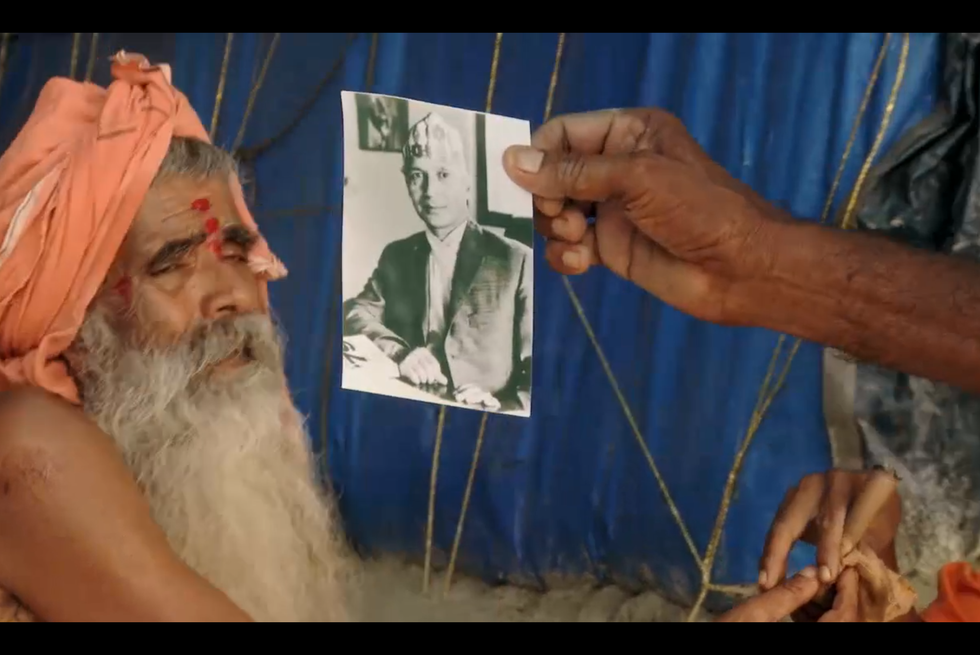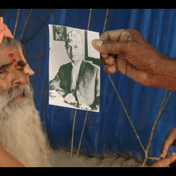
Perhaps the best place to start with Kesang Tseten’s Castaway Man (2015) is with its final scene—with grainy archival footage of a man burying a time capsule in the earth. Children and adults look on, sitting in neat rows on the dusty ground. A chorus of womens’ voices merge in a Jumli folk song, an accidental soundtrack. Dor Bahadur Bista, the anthropologist, stands nearby as the time capsule is buried. He tells the villagers that only after one hundred years have passed can they unearth the capsule and read its contents. “This document,” he says “will reveal my message and my dream.”
The crux of Bista’s anthropological work focuses on critiquing the injustices of caste hierarchy and Brahmanism in Nepal. Bista, himself a Brahman, was raised in an elite family in Kathmandu. While his youth was spent reaping the benefits of chakari, currying favor with people in high places, he later devoted his career to critiquing the systems of privilege and power into which he had been born. Speaking of his drive to pursue anthropology as cultural critique, we hear Bista explain “our job is to unsettle society,” quoting Clifford Geertz. Bista’s (1991) major work, Fatalism and Development: Nepal’s Struggle for Modernization, argues that Brahmanism and notions of fatalism, the idea that what you are is always already decided, were blocking Nepal from developing as a nation. Taking the ideas developed in his text, in the early 1990s Bista set out to the far western hills of Jumla to dream his theory into practice. There he built the Karnali Institute, an educational center and utopian vision for rural development and a non-hierarchical society. Yet Bista’s “dream” is also the dream of development as modernity and progress, a telos which itself is not critiqued.
Five years later, a growing insurgent movement of Maoists in this very region would launch the People’s War, demanding an end to the monarchy, liberation from Indian imperialism in Nepal, and the abolishment of gender, caste, and ethnic hierarchies. The war between the Maoists and the state would continue over the next ten years. In Jumla, Tseten’s camera meets local people who reflect on Bista, his vision, and what might have been. “He had no caste bias, that is also the Maoist philosophy—that we are all equal,” a local man explains as he walks through the ruins of the Karnali Institute, books and materials long gone. Slowly we learn of the tensions that haunted the anthropologists’ work in this conservative community—rumors of an affair with a local woman published in a national newspaper make it clear that Bista had enemies. Soon after this event, he disappears.
Castaway Man tells the story of the life, work, and untimely disappearance of Dor Bahadur Bista, “the father of anthropology in Nepal.” Bista began his anthropological work as the research assistant of Austrian ethnologist Christoph von Fürer-Haimendorf after Nepal first opened its borders to foreigners in 1951. While Bista wanted to pursue a PhD in anthropology at SOAS in London, Haimendorf continued to treat Bista as an informant and actively blocked him from pursuing his own research. In the film, Bista recalls this period, saying, “I was treated outright as a field assistant and informant. Period. Therefore, increasingly I began to feel suffocated. Haimendorf didn’t want me to finish my degree in anthropology—and didn’t want me to come back to London. So now I had to prepare myself to be an unorthodox–formally speaking, unqualified—and yet seriously involved anthropologist, without a formal degree and without formal recognition.”
Here we are confronted with the hierarchies of academic anthropology. Like many BIPOC anthropologists in American anthropology at the turn of the twentieth century, in Haimendorf’s neo-colonial understanding of the discipline, Bista was left no choice but to pursue anthropology outside of its institutionally sanctioned pathways and centers of knowledge. Bista’s story is not only important for an anthropology of Nepal, but for the view it opens onto world anthropologies and the stakes of critical research beyond the familiar figures of the Euro-American nexus and its excluded others (see also Riberio and Escobar 2006). What would it mean to tell Bista’s story in an introductory cultural anthropology course?
The genius of Castaway Man is found in Tsesten’s construction of the film as search. The film, this search, could also be understood as research, as rumination. Through travels into places and archives, the film conjures the stakes of Bista’s critical anthropology—his movement between ideas and practice, and the blossoming of a Nepal that, he hoped, would shake loose from the constraints of its caste system and the elite levels of society it serves. The camera takes us from Kathmandu to Jumla, to the holy Hindu city of Haridwar and beyond, moving deftly across the diverse regions and social worlds of the Himalayas. Along a mountain forest path, Tseten puts Bista’s theories into moving-images as we meet ordinary people who reflect on the ways in which caste and ethnicity have shaped their own lives. At the same time, Tseten frames his search into Bista’s past alongside the real-time work of translation of Bista’s writing from English into Nepali, so that it might finally appear for the first time in the anthropologist’s native language.
References
Bista, Dor Bahadur. 1991. Fatalism and Development: Nepal’s Struggle for Modernization. Hyderabad, India: Orient Blackswan.
Ribeiro, Gustavo L., and Arturo Escobar, eds. 2006. World Anthropologies: Disciplinary Transformations within Systems of Power. Oxford: Berg.
Posts in This Series

Anthropology in the Margins
Castaway Man (2015), directed by Kesang Tseten, begins with a translator’s journey to Haridwar in the Indian Himalayas. He is looking for clues about Dor Bahadu... More

Theorizing Privilege with Dor Bahadur Bista
Dor Bahadur Bista’s (1991) Fatalism and Development: Nepal’s Struggle for Modernization is the only book of which I own three copies. I bought my first copy in ... More